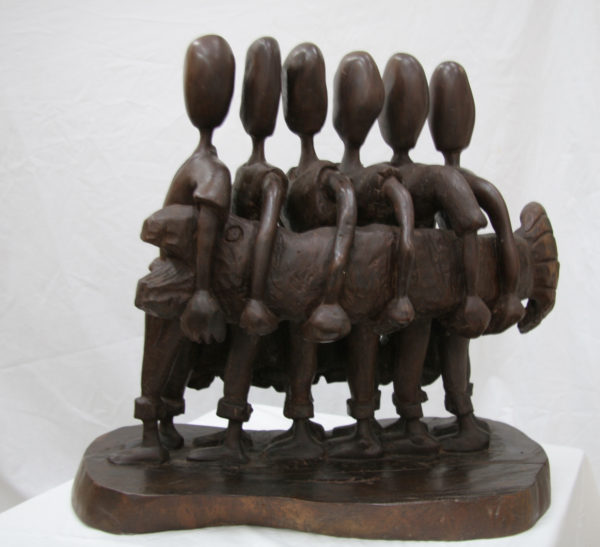Artists Stanley Greaves AA and Akima McPherson in this their 17th Conversation on Art discuss George Hope’s Mahagony sculpture Progress Through Unity, which is undated. Progress Through Unity will be available for viewing at the National Gallery of Art, Castellani House during the month of August.
Stanley Greaves: One of the interesting differences between sculpture and painting is the way that sculpture occupies three-dimensional space whereas painting can create the illusion of space. Because of its small scale, the sculpture Progress Through Unity by George Hope tends to be overlooked. It did catch my attention the first time I saw it, the same for Denis Williams (the late Director of Art), who acquired it for the National Collection. Hope’s title reflects the socialist political agenda of the 1970s. While the theme does the same thing, it can and does embody a message that transcends the agenda.

Mahogany Courtesy of the National Collection
Akima McPherson: George Hope’s Progress Through Unity works well at its current diminutive size. It makes for quiet contemplation. Reading it is like reading a novel – a very solitary and individual endeavour. At a larger size, or certainly at a monumental scale, it would have lent itself to a community reading and so it’s clear and simple message would have greater impact. But that is the problem with art making; as artists we are sometimes limited by materials or by what the market may respond to intellectually and financially. Can you say whether Hope was an artist who frequented this kind of theme and content which was political and reflective, or was this atypical work from him?
SG: I am only aware of this particular work by him. Working as an artist in a population that has not passed through any system of visual education presents problems for any artist looking for appreciation and understanding of work produced. I would say that the term ‘market’ presents art as a commodity which is totally inappropriate for a discipline that is aimed at the exploration of ideas. The artist is always limited by available resources. It is an issue of what can be done with them as in the Found Objects movement. Progress Through Unity says many things depending on what the viewer brings to it. The big fish can suggest the arapaima, the largest freshwater fish in the world. The fact that the men carrying it have no faces could mean any group of individuals working together for the common good. Looking at the group moving together as if in some kind of celebratory dance seems somehow to create a sense of quiet humour.
AM: I understand your point regarding the term ‘market’. In using the term I made a loose reference to the art-buying public.
However, the reality is – art has become a commodity and there is a well-established complex market for it; some artists benefit more handsomely than others from it. My own leanings are for movements of the 1960s and after, which are characterised by rejection of art as a commodity such as Earth art, Happenings and work of a conceptual nature that challenges commoditisation.
I have a preference for political art so as you say, in looking at Progress Through Unity I see a proletariat mass (lacking individualising) working in unison to achieve an end unknown to them, as workers.
It’s a great work for a Marxist art critical evaluation. With the title taken into consideration in relation to the work’s form (how the theme presents itself physically) and the social and political context one can see a nationalist statement complete with reference to Guyana’s six races.





